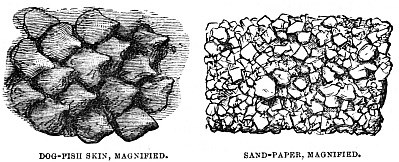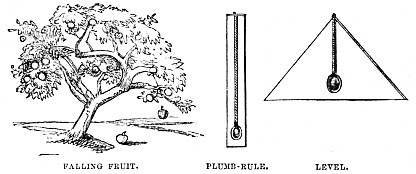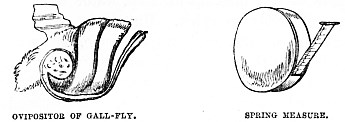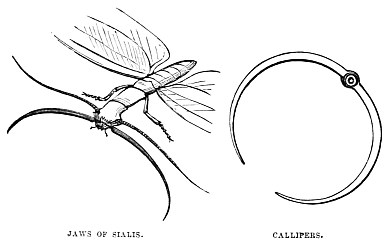 полная версия
полная версияNature's Teachings
The power of the Crab’s claws is so great that a bite from a large Crab will inflict a severe injury, and render a hand helpless. It has more than once happened that men who have been feeling for Crabs in the recesses of the rocks at low water have been seized, and seriously imperilled, not being able to release themselves from the gripe.
Indeed, it is said that there have been instances where the Crab has held so tightly, that the man has been drowned by the returning tide, no one having come to his assistance. I am, however, inclined to doubt this statement, thinking that the Crab would not be likely to remain in its hiding-place very long after the water came up. Still, that such an idea should be currently believed in many parts of England shows the estimation in which the gripe of the Crab’s claw is held.
CHAPTER IV.
POLISHING TOOLS.—MEASURING TOOLS
Files and Sand-papers.—The Sheffield File and its Structure.—The Equisetum, Mare’s Tail, or Dutch Rush.—Beauty of its Surface when seen through the Microscope.—Sand-paper.—Skin of Dog-fish, Skate, and Shark.—Skate-skin used for Sword-handles.—Distinction between the File and Sand-paper.—Measuring Tools.—The Plumb-rule and the Level.—Their Use in Tunnelling.—The Measure and its Uses.—The Two-foot Rule and the Tape Measure.—Ovipositor of Gall-fly.—Tongues of the Woodpecker, Wryneck, and Creeper.—The Spirit-level and its Uses.—Theodolite and Callipers in Nature and Art.—The Contouring-glass.—Pincers of Earwig again.—Jaws of Insects.—The great Sialis of Columbia.
Files and Sand-papersHAVING now examined the analogies between the cutting, boring, striking and grasping tools of Nature and Art, we come to those finishing tools which smooth and polish the surface.
The first is the File, an instrument which needs but little description. It consists of a surface of hardened steel, broken up into rough-edged teeth of infinite variety, according to the work which the file has to do. It is rather remarkable, by the way, that at present the English files are infinitely superior to those produced in any other part of the world; that their teeth are all made by hand; and that a genuine Sheffield file will first cut its way through a piece of iron in half the time that would be occupied by a file of any other nation, and then would easily cut its antagonist in two.
As long as the File is intended to work upon metal, there is little difficulty in its manufacture, except that no machinery has yet been invented which can give the peculiar edging of the ridges, and to which is owing the unmistakable “bite” of a real English file.
But there are occasions when the hand of the most cunning file-maker is baffled, and when it is necessary to cut files so delicate that the unaided human eye cannot trace their teeth. Art, therefore, has recourse to Nature, and the cabinet-maker, who cannot obtain any file made by human hands which will answer his purpose in the higher branches of his trade, makes great use of the “Dutch Rush,” as he calls it. It is not a rush at all, but simply a species of Mare’s Tail, or Equisetum, a plant which fills in profusion almost every marshy spot in England.

The peculiar fitness of the Equisetum for this purpose cannot be appreciated even by those who use it until it has been viewed under the microscope. I have now before me a small piece of Equisetum, placed under a half-inch power, and viewed by direct illumination, it being treated as an opaque object.
The microscope reveals at a glance the source of the power which the ingenuity of man has taken advantage of. The surface of the Equisetum is seen to be composed of myriads of tiny parallel ridges, each ridge bristling with rows of flinty spicules, looking very much like the broken glass upon the top of a wall. Minute as they are, these spicules can do their work, and they enable the joiner to finish off work in a manner that could not be accomplished by any tool made by human hands.
I find, by recent inquiries, that modern joiners scarcely, if ever, use the Equisetum, preferring emery-paper as cheaper and more expeditious, and knowing that the popular eye is not able to appreciate the difference of the surface obtained by the Equisetum from that which is given by the finest emery-paper ever made. Wood-carvers, however, if they be of the conscientious kind, and love their work for its own sake, adhere to the Dutch Rush, and are all the happier for it.
Pass we now to the coarser kinds of polishers, the chief of which is popularly known as Sand-paper, and is made by coating some tissue with glue, and scattering upon it sand of different qualities, according to the work to be done. Sometimes, when the work is rough, the sand is large, rough, and coarse, and sometimes, when the work is fine, the sand is so carefully sifted before it is scattered on the glued paper, that there is little distinction between the sand-paper and emery-paper. Linen, by the way, is generally used instead of paper, as being more enduring, less liable to crack, and capable of being folded so as to obtain access to crevices which paper could not touch.

Again in Nature we find a parallel, and the coarse Sand-paper of modern Art has long been anticipated in the scale-clad skins of many fishes.
The accompanying illustration is taken from the skin of a Picked Dog-fish found by myself lying dead on the rocks in Bideford Bay. I cut off a piece for transmission to the draftsman, and found that not only did it feel exactly like cutting through a piece of very common sand-paper, but that it blunted the edge of a new knife in exactly the same manner as would have been done by the roughest of sand-paper.
This kind of skin is common to all the shark tribe (including the Dog-fishes, which are but sharks in miniature), and to the Skate, Saw-fish, &c. I have now before me a small, but perfect example of the Saw-fish, the surface of which is covered with flinty scales like those of the Dog-fish, but very much smaller, requiring the aid of a magnifying lens to distinguish them. Even to guess at the number of them is impossible, for they cover the whole of the body, and extend to the very end of the beak, in some places glittering in a strong light as if pounded glass had been sprinkled all over the fish. One of the most interesting points in their structure is the manner in which they reach the rounded jaws, and there become converted into teeth powerful enough to crush the animals on which the fish live. The structure of these jaws will be explained in a future chapter.
Some of the skates and sharks have these scales of great size, so as to show their formation almost without the aid of a magnifying-glass. This is the case with a species of skate, the skin of which is used by the Japanese for wrapping round the handles of their best swords, and which is greatly valued by that nation, the sword being an almost sacred article in the eyes of a Japanese.
There is a well-known museum in which these swords are labelled as having handles of “granulated ivory.” Now, in the first place, there is no such thing as granulated ivory; and, in the next, a mere glance ought to tell the observer that the so-called ivory is a skin of some sort, worked upon the handle while wet, and kept in its place by copper studs. Even the junction of the edges is perceptible, and yet the authorities of the museum in question, although they have been repeatedly corrected, still persist in calling the skate-skin by the absurd title of granulated ivory.
However, if ivory could be granulated, it would certainly look very much like the skate-skin. When examined closely, the scales, whether of Dog-fish, Skate, Shark, or Saw-fish, are seen to resemble hexagonal cones, not coming quite to a point, but truncated, so as to have an hexagonal flattened tip. They are almost of a flinty hardness, especially at their tips, and on inspection of them the observer is not surprised at the use of Dog-fish skin in place of sand-paper.
Perhaps the reader may ask why the Equisetum should be taken as the prototype of the file, and the skin of the Dog-fish as that of sand-paper. The reason is this. The flinty points of the Equisetum are set upon parallel ridges something like those of a file, while the scales of the Dog-fish are without any apparent order, being crowded against each other like the cutting particles upon the sand-paper. That there should not be an order, and that a definite one, is out of the question. But it has not yet been detected by human eyes, and therefore may be practically treated as non-existent.
Tools of MeasurementIn many of the arts, more especially those which belong to engineering and carpentering as a part of architecture, it is absolutely necessary to make sure of a perpendicular line, i.e. a line which, if continued, would reach from any point of the earth’s surface to its exact centre below and its zenith above. Were it not for the power of producing this line, none of the great engineering works of modern or ancient days could have been undertaken.
Take, for example, the wonderful tunnels which have been driven through the earth, of which the Mont Cenis Tunnel is one of the greatest triumphs of modern engineering. Beginning, as the workmen did, at opposite ends of a tunnel many miles in length, and labouring only by the lines laid down by the engineers, the men worked steadily on until they met in the centre.
A few blows, and the then narrow dividing wall was shattered, the men shook hands through the aperture, and then, after enlarging it, leaped wildly from one side to the other, having successfully solved the great problem. With such marvellous precision had the lines been laid, that only a few inches had to be smoothed down on either side, and the sides or walls of the tunnel showed no traces of the junction.
So rapid has been the progress of engineering that a tunnel of a mile in length would, within the memory of man, have been thought as daring a project as was the Mont Cenis Tunnel, which has just been given as an example. Indeed, I know of a railway tunnel, not quite a mile in length, where the engineers had committed some error, so that the two halves, instead of meeting exactly, overlapped each other so much that the mistake was only discovered by the workmen, who heard the strokes of their companions’ picks on their sides, and not in front. Consequently, a great waste of time took place, and the centre of the tunnel had to be made with a double curve, like the letter S, and trains are obliged to slacken speed until they have passed it.
Those who have lived long enough to remember the current literature of the past generation will call to mind the ridicule that was cast upon the idea of a tunnel that should pass under the Thames. That it would be useful if it could be completed, no one ventured to doubt, but that such an idea could be conceived by any one out of a lunatic asylum was rather too much for the journalists of the day. However, the tunnel was made, and so proved the theorists wrong on the one side. And, when made, it was of very little use, which proved them wrong on the other side. Now the proposal to carry a submarine tunnel from England to France excites not half the opposition that was elicited by the comparative child’s-play of a tunnel under the Thames.
The only mode of laying down the lines on which the men worked is by suspending very heavy balls to very fine wires, and then, by means of delicate optical instruments, ascertaining whether the wires are in line with each other.
Familiar instances of the use of this principle may be seen in the plumb-rule and level of the builder or carpenter. The latter, with a base of ten feet in length, is often used by the gardener when he wishes to lay the absolutely level lawns that are required for our modern game of croquet, where the hoops are scarcely wider than the balls, and the lawn has in consequence to be nearly as level as a billiard table.
I may here remark that the name plumb-rule is derived from the Latin word plumbum, or lead, in allusion to the leaden weight at the end of the string. The word “plumber” is due to the same source, and signifies a worker in lead.
These invaluable aids to the development of civilisation are due to one principle, namely, that which we call Gravitation, but which ought more properly to be termed Attraction, and which attracts all parts of the earth towards its centre. We are all familiar with the anecdote of Newton and the falling apple, which may be true or not, but which at all events bears on the present subject. No matter on what portion of the spherical earth a tree may be, every fruit becoming disengaged from it is attracted to the earth, the line which it takes, unless disturbed by external forces (such as wind, &c.), being that which passes from the zenith to the centre of the earth.

This imaginary line is a perfect perpendicular, and the visible line which is formed by the delicate wire of the tunnel-boring engineering instrument, or the comparatively coarse string of the plumb-rule and level, are approximations sufficiently close for practical purposes. So it is in a mathematical proposition. As mathematical lines have no breadth, they are simply indicated or represented by the lines of the figure, the bodily eye being incapable of seeing what is perfectly visible to the mental eye, namely, length without width. So the wire and string perform in practical work exactly the same office which is fulfilled by the lines of a mathematical proposition drawn on paper.
We have already, when treating of the Fall-trap, seen how this principle is brought into operation by those who are utterly incapable of discerning the physical principle, though they can apply it materially with wonderful effect.
It is, perhaps, needless to mention the value of the Measure to any handicraftsman.
I well remember that when, some twenty-four years ago, I was taking lessons from a carpenter in the art of making ladders, gates, fences, hurdles, and other rough-and-ready work, my quaint old tutor related an anecdote of and against himself. He very ingeniously set me to work at boring the auger-holes in the gate-posts which were to be united by the mortise chisel and mallet, and to sweeten the rather severe, because unaccustomed, labour, told me that, when he was a boy, he was doing just the same thing.
Being rather tired of twisting the auger handle (and no wonder either), he withdrew the instrument, and put his finger into the hole by way of ascertaining its depth. Immediately he found himself on his back, having received a tremendous box on the ear from his father, whose parental wrath was excited by the idea of his son condescending to use his finger by way of measure, when he had a two-foot rule in its own special pocket.
There are, however, many cases where even a two-foot rule would be insufficient for the work, and where a measure of thirty or forty feet is needed.
Now, there is no doubt that by means of a two-foot, or even a six-inch, rule any number of feet might be measured accurately; but, considering the number of junctions that have to be made, it is not likely that any pretence to accuracy could be insured.
Then, a rod of forty, or even of twenty, feet in length would be awkward and unmanageable, and the only plan left is to take a string or cord of the requisite length.
Even here, however, is a difficulty. The string would not allow of short measurements, such as inches, being written upon it. Let, however, a broad tape of inelastic material be substituted for the string, and all is easy enough.
The next plan is to provide for the portability of the tape in question, to insure its reduction into the smallest possible compass, and to be sure that it is not twisted so as to damage its accuracy. These objects are all attained by the ordinary Tape Measure of the present day, which, whether it be a yard measure in a lady’s workbox, or a surveyor’s measuring tape, is a ribbon of comparatively inelastic material, coiled up when not wanted, and capable of being drawn out to its fullest extreme when needed.
Putting aside the breadth of the line, and consequently disregarding the liability to twist, we have in the Fishing-reel of the modern angler an exact case in point. So we have in the lady’s yard measure, and in the gardener’s or builder’s tape, all these being modifications of the same idea.

Suppose now that we pass to Nature, so as to ascertain whether any such provisions were in existence before it was imitated, however unconsciously, by man. This certainly was the case with one of the commonest and most insignificant of our insects, the little Gall-fly, belonging to the genus Cynips. It could not lay its eggs without the aid of a very long ovipositor, and, owing to structural details, it cannot carry that ovipositor in a straight line, as is done by many insects, some of which have already been mentioned. Accordingly, it is coiled up exactly like our measuring tapes, and can be unrolled when needed. The long, protrusible tongues of the Wryneck, Creeper, and Woodpecker are examples of a similar structure, the tendinous portions being coiled round the head when not needed.
The Spirit-levelHaving now seen how the forces of Nature enable us to produce a perfectly perpendicular line, we will see how the same force, though applied in a different manner, enables us to produce a perfectly horizontal line, the intersection of the two lines producing a right angle.

The measuring tool in question is called the Spirit-level, and is represented on the right hand of the accompanying illustration. Its construction is very simple, consisting of a tube, nearly filled with spirit, and having just one bubble of air in it. Now, owing to the force of gravitation, the air-bubble must always be uppermost. Consequently, if the tube be a perfect cylinder, whenever it is held so that the bubble is in the centre, the tube must be horizontal, a hair’s breadth of deviation altering the line. I may here mention that, as far as the principle of the instrument goes, water would serve the purpose as effectively as spirit. But as in cold weather the water might freeze, and so burst the tube, as well as being useless until it was thawed, spirit is always substituted.
This instrument is used for various purposes. Sometimes it is employed for levelling billiard tables, or for ascertaining the exact level of walls and other parts of buildings. Surveyors could scarcely do their work without the Spirit-level, which forms an important part of their chief instrument, the theodolite. Indeed, the new science of land drainage, by which the tough, unproductive clay soil is converted into fertile earth, is entirely dependent on the use of the Spirit-level, which detects the slightest rise or fall in the ground.
A most ingenious modification of the Spirit-level is used by military engineers, and is known by the name of the “Contouring-glass,” a term which requires some explanation.
It is of the utmost importance that a military engineer should be able, whether on foot or on horseback, to ascertain the approximate heights of the various points which he visits, the efficiency or failure of a battery very much depending on the comparative elevation of the spot on which the battery is placed, and that of the place against which its fire is directed. In an unknown country, of which no detailed maps exist, an invading force must of necessity depend on the extemporised surveys of their engineer officers, and one of the most valuable of their devices is the system of Contouring, invented, as far as I know, by the late Colonel Hutchinson, R.E.
The idea is simple enough. A hill is seen, and the engineer makes a sketch of it before he ascends. At the foot he halts, and marks the spot where his foot presses the earth. He then looks in front at a spot exactly on the level of his eye, marks it, and walks to it. He then draws a line across his sketch, at the exact spot on which he is standing, and that is the first “contouring line.” Others follow, until he has reached the top of the hill.
Now, if he can trust himself to look exactly horizontally, he has ascertained the elevation of every part of the hill. He knows the height of his eye from the sole of his foot, and calculates accordingly. Suppose, for example, that it be five feet, and that ten contouring lines are marked, he knows that the entire height is fifty feet, and that each line means an elevation of five feet.
This is a very excellent theory, but one which is not reduced to practice so easily as it looks. There is nothing more deceptive than a contour, especially upon an irregular hill, the invariable mistakes being either greatly to overrate or underrate the height of the contour. When I took my first lesson in this art I caused much amusement to the professor under whom I was studying, by making Shooter’s Hill consist of about seventeen contours. However, as many military students made very much the same mistake, I was not so humiliated as I supposed.
Of course, if a surveying officer be mounted, he takes the contour line as measured from his eye to the ground through the centre of the saddle.
After some practice the eye becomes so much accustomed to the contouring lines that they are taken almost mechanically; but, until this result be gained, an absolute proof is needed, which is furnished by the Contouring-glass—which, by the way, is not a glass at all, after the common acceptation of the word.
It is a simple brass tube about three inches long, not thicker than a man’s little finger, and open throughout. A small spirit-level is fixed on its lower surface, and on the very centre of the upper surface is a tiny steel mirror, which projects downwards like a knife-blade. In order to get a “contour,” the observer looks through the tube, slightly depressing its end. He then gradually raises it, still looking through it. As the tube becomes exactly horizontal the bubble in the spirit-level is reflected in the little mirror, and the object on which the tube is directed is in consequence on a level with the observer’s eye.
At first the management of the contouring-glass is rather tedious; but after a little practice it can be used without pausing for a single step.
Invaluable as is the Spirit-level, with its various modifications, it is nothing but an adaptation of that natural law which causes the bubbles to float on the surface of a stream instead of being submerged below it. We have all seen the multitudinous bubbles of soda-water, or of any effervescing liquid, and have noticed how they are very small when generated, but enlarge quickly, and rise to the surface with a rapidity equal to their enlargement. The same phenomena may be observed in any water-fall, or even in the very familiar and unpoetical operation of pouring beer from a jug into a glass.
The reader will see that in the plumb-rule, the level, and the spirit-level one single principle is employed, namely, the attraction of matter towards the centre of the earth. In the two former instruments this attraction gives a vertical line, and in the latter it gives a horizontal line, but the principle is the same in both.
Callipers
We conclude the history of measuring tools with the Callipers. For ordinary purposes, and upon a plane surface, the Compasses answer every purpose. But there are various arts, especially sculpture, in which the compasses, with their straight legs, are absolutely valueless, and their place must be supplied by a differently shaped instrument. For example, no ordinary compasses could measure the exact distance from the nostril to the back of the head, or even touch two points at opposite sides of a limb, and it is therefore necessary to have compasses with curved legs. These are termed Callipers, and can be used on a plane as well as on a rounded surface.
Natural Callipers are plentiful enough, and may be found extensively among the insect tribes. There are, for example, the pincers of the Earwig, which have already been described on page 259, and which are, in the common species, formed exactly like the Callipers of the sculptor.






